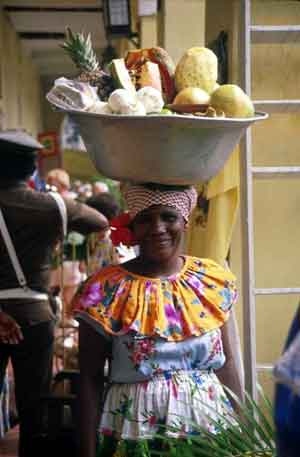|
The only South
American country with coasts on both the Pacific and the
Atlantic oceans, Colombia was part of the Spanish viceroyalty
of New Granada. The United States of Colombia, which also
included Panama, Venezuela and Ecuador was proclaimed in 1819
by Simón Bolívar when he crossed the Andes and defeated the
royalist forces at the battle of Boyacá. In 1822 the four
countries were united as Gran Colombia, which collapsed in
1830 with the separation of Venezuela and Ecuador. The
republic of Colombia was established in 1886, but Panama
separated in 1903, after the US-backed War of the Thousand
Days (1899-1902).
Irish soldiers
fought in Colombia during the War of Independence with Spain
in 1816-1822. They were recruited in Dublin, London and other
cities by John Devereux, James T. English, William Walton and
others. The Irish Legion sailed from Liverpool in July 1819.
Some of the officers were Major L'Estrange, Francis Burdett
O'Connor, and William Aylmer. They arrived in the island of
Margarita, where they suffered hardships, sickness and loss of
life. In March 1820 the Legion sailed to Río Hacha, and after
the attack to this city, their standard displaying the harp of
Ireland was raised instead of the Spanish royal ensign.
Weakened by lack of pay and proper food, and complaining of
the native officers, some of the Irish mutinied, got drunk and
began to ransack the city for booty. The mutineers were
transported to Jamaica and turned over to the British
authorities. O'Connor's lancers continued the campaign and
reached Cartagena by the end of 1822, and effectively assisted
Bolívar at the decisive battle of Boyacá. The chief
responsible for the formation of the Irish Legion, John
Devereux, did not arrive at South America until 1821. He never
took part in a single engagement with the Legion, but he made
a pretty profit in organizing it. However, Simón Bolívar
absolved Devereux from any blame and in 1822 attached him to
the general staff at Bogotá. In 1823 John Devereux was
appointed Colombian envoy to the courts of northern Europe.
Some of the
soldiers of the Irish Legion remained in Colombia after the
War of Independence. After the battle of Boyacá, Daniel
Florence O'Leary (1801-1854) was appointed Bolívar's
aide-de-camp and served in Venezuela, Panama, Ecuador, Peru
and Bolivia. In 1828 O'Leary married Soledad Soublette in
Bogotá and lent valuable services to Colombia and Venezuela.
His memoirs, published posthumously by his son Simón Bolívar
O'Leary, remain a basic reference for students of the South
American Wars of Independence. Beatriz O'Connell, related to
the Liberator Daniel O'Connell, married Manuel Pombo in 1795
in Madrid, and in 1819 was living in Bogotá. Other Irish
settlers in Colombia related to the Wars of Independence were
Thomas Murray (d.1823), who married Estrada Callejas, John
Hands, Francis O'Farrell (known as Francisco Puyana), Joseph
Boylan, Robert Lee, James Rooke, and the physicians Dr. Hugh
Blair Brown (surgeon of the Arthur Sandes' Rifles in Peru),
Dr. Kennedy, Dr. Williamson, and Dr. McEwen.
Almost 150
years later, a new type of legion arrived in Colombia, though
this time peacefully. In 1953 the Catholic lay movement Legion
of Mary sent Seamus Grace and Alphie Lamb (1932-1959) to
Bogotá to expand their mission in Colombia. From the capital,
Grace and Lamb established many Legion branches (praesidia) in
other parts of the country. They visited bishops and obtained
their permission to set up in their dioceses. The Legion
flourished around Colombia, especially among the poor, and
then expanded to Ecuador, Venezuela and throughout South
America.
The most
recent chapter in the history of Colombian-Irish relations
allegedly connects the Irish Republican Army (IRA) and the
Revolutionary Armed Forces of Colombia (FARC). On 11 August
2001, Jim Monaghan, Niall Connolly, and Martin McCauley were
arrested at Bogotá's airport, accused of being IRA members
providing explosives training to FARC in the demilitarised
zone of San Vicente del Caguán in southern Colombia.
Established in 1964 as the military wing of the Colombian
Communist Party, FARC is the largest irregular army in
Latin America. Washington accuses FARC and other 'narco-terrorists'
of profiting from the illegal drug production and distribution
business. The three Irishmen were travelling on false
passports. At first they said they were bird-watching but
later added they were studying the Colombia peace process.
Their initial acquittal in April 2004 was overturned by a
higher court, which imposed sentences of seventeen years on
each of them. They escaped from Colombia and in August 2005 –
a week after the IRA proclaimed the end of its military
operations – they arrived safely in Ireland. The Colombian
authorities have formally required their extradition.
Edmundo
Murray
Adapted from: Jim Byrne, Philip
Coleman and Jason King (eds.), Ireland and the Americas:
Culture, Politics and History (Santa Barbara, CA: ABC-CLIO,
forthcoming 2006), with kind permission of the publisher.
References
- Barnwell,
David. William Duane and his "Visit to Colombia" of 1823, paper
presented at the CAIS annual conference in Maynooth, 22-26 June
2005.
- Hasbrouck,
Alfred. Foreign Legionaries in the Liberation of Spanish South
America. New York: Columbia University, 1928.
- Kirby, Peadar.
Ireland and Latin America: Links and Lessons. Dublin: Trócaire,
1992.
See also The Irish in Latin
America and Iberia: A Bibliography (Colombia, Venezuela). [document]
|


